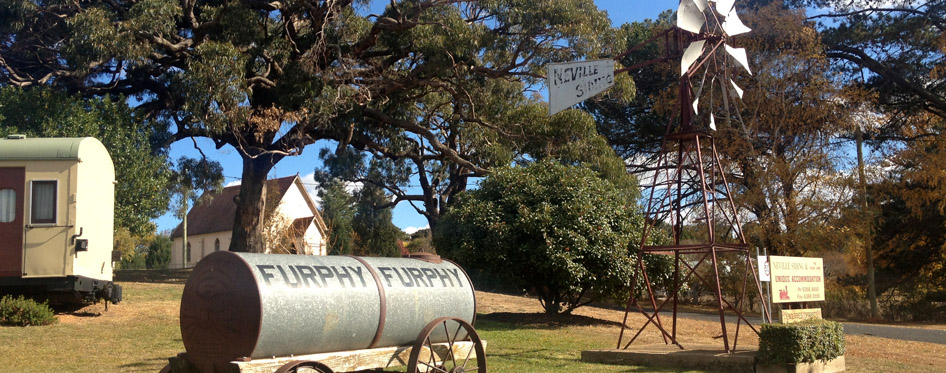Tucked away in a quiet corner of the Blayney shire is the Village of Neville, only 3.5 hours hours from Sydney. Now a sleepy little village of only 100 residents, Neville was once a thriving township. It has been documented that it may have had its beginnings as early as 1815 when the explorer George Evans, under instruction from Governer Lachlan Macquarie to explore the Blue Mountains and beyond, passed close to the present day village.
Before 1850, there were only two grants of Crown land in the area, but many more grants were later issued with a resulting influx of residents. Many descendants of the original landowners still reside in Neville today.
The early settlers were keen to develop the township and in 1858 a small school was established. 1866 saw the Presbyterian Church built followed by the Church of England in 1875. A Post Office was established in 1870. The land occupied by the village store was purchaed in 1897 and the post office and later the telephone exchange were incorporated within the store. The School of Arts opened in 1890. The Catholic Church was built in 1897 and a recreation ground notified in 1898.
During its period of growth Neville established itself as a township with a co-operative butter company, dressmakers and milliners, a dentist, wheelwright, blacksmiths, motor mechanics, butcher shops, saddler, stock and station agency, slaughterhouse, fruit shop, banker, brick maker, bakehouse and the renowned Colburt's beer. Unfortunately all of these businesses have long disappeared. Some Chinese built sluices and panned for gold down the hills and precious opal was documented as early as 1875.
Social activities were a highlight of the village's early days. It had the states biggest lamb show; roller skating was held in the community hall, and the town's brass band would play outside the hotel on Saturdays. Neville has fielded tennis, cricket, rifle shooting, gymkhanas and football teams over the years. Grand balls and dances were often held in the community hall too.
The present Neville Hotel was built in 1929 replacing its predecessor - The No. One Hotel - that was gutted by fire in 1926.
Within the village's Park a memorial has been erected in memory of the many local men and women who died at war. Rememberance services are still held at the War Memorial on appropriate days.
Neville has a well maintained Cemetary with many historical family graves including including descendants of the bushranger John Vane. Also, scattered throughout the district on Church land and private properties are the graves of some of the earliest settlers.
Neville - the village today
The residents today continue to farm the land with the district having the reputation of being one of the safest agricultural areas in the state. Beef and sheep can be seen on nearby farms along with oil crops and cereals.
The weather in Neville is cold in winter and snow sometimes falls several times a year. The summers are warm and autumn brings abundant colour in the falling leaves. In spring, gardens abound with the scent of roses and the colour of rhododendrons and daffodils.
The townsfolk are proud of their school and the Neville Public School is an important part of village life with involvement in school activities being encouraged and welcomed from members of the community. The school offers specialist teachers in literacy, art, music, computing and technology and has a weekly Birth to Kinder program.
Neville has two active churches offering services and fellowship groups. The community hall continues to bring residents of the district together with functions being held throughout the year - Christmas in July and the Bush Poets' Night being community favourites. A family Kite Day is held annually at the showground and the Neville Show is held each November. Tourist accommodation is available at Neville Siding.
The Neville Hotel has a welcoming atmosphere and serves meals daily with its fish and chips on Friday nights having the reputation of being the best in the district.
The Neville Rural Fire Service is very strongly supported by the community. Continual training is offered to the volunteers by the NSW Forestry Commission in the 514 hectares of the Neville, Roseberg and Pennsylvania State Forests. Within these Forests bushwalking, camping and 4WD are encouraged. Living within the forests are many interesting species of wildlife, birdlife and native plants including possums, wallablies, echidnas, honey eaters, scrub wrens, kookaburras, sun orchids and native flax lillies.
Neville is in close proximity to the Limestone Caves of Abercrombie, Mount Panorama Race Track, the heritage cities of Orange and Bathurst and the historial villages of Millthorpe and Carcoar. Also the nenowned Japanese Gardens at Cowra are only a short drive away.
The History of Neville Siding
Neville Siding was established in 1987 By Ted and Betty Wilson to provide a unique accommodation facility catering to travellers and visitors to the area whether for holidays, family visits or work related activities. The philosophy behind the concept was to provide self contained and affordable accommodation as part of an experience of being in the bush and enjoying rural life.

The 1880's Mandurama Railway Station and 2 vintage 1950's Guard's Vans and Caboose were moved on site and with the addition of Railway's signage and items from around Australia, the railway theme was set. In the late 1990's three Railway Dongas (accommodation left at sidings for railway men working on country lines), 2 ablution blocks and another unit were brought onto the site and placed into a square surrounding a courtyard, local businesses manufactured the shed to cover the complex and 'The Goods Shed' was born - a serviceable & modern kitchen was built and the whole establishment decorated with memorabilia.
Ted was an avid collector, Neville Siding has been run by Betty Wilson after the death of Ted in 2008 from Motor Neurone Disease. (Well done Betty). Neville Siding will now be run by Kevin and Jennene Radburn.


